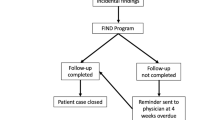Abstract
OBJECTIVES: To assess whether the joint review of radiologic studies by the primary care physician and the radiologist affects patient care and health care costs.
DESIGN: Prospective study.
SETTING: Student health clinic at a university hospital.
PATIENTS: University students seen during acute care visits.
INTERVENTION: Joint weekly review of all radiologic studies ordered at the student health clinic between July 1992 and June 1993 by a staff radiologist and internist.
MEASUREMENTS AND MAIN RESULTS: The outcome measures were: (1) change of radiologic diagnosis after review process and its effect on patient management; (2) expenses saved or incurred by the review process. Of 323 films ordered, 305 were reviewed, resulting in revisions of 23 (8%) of the initial readings. Sixteen revisions (5%) led to a change in patient management; the remainder were clinically insignificant. In these 16 cases, cancellation or simplification of further workup resulted in savings of $1.967. The cost for extra physician time was $5,499. Thus, the review process incurred a net cost of $3,532. Except for the reduction in diagnostic studies, no therapeutic benefit for the patients could be identified. Film readings in our radiology department were conservative, with a positive predictive value of 85% and a negative predictive value of 99.7%.
CONCLUSIONS: Routinely reviewing every radiologic study did not affect patient outcome in an outpatient clinic with low prevalence of disease. Given our radiologists’ conservative film-reading practice, a review of only abnormal studies may prove more cost-effective in a healthy population. This type of assessment has implications for improving the efficiency of a changing health care system.
Similar content being viewed by others
References
Yerushalmy J. The statistical assessment of variability in observer perception and description of roentgenographic pulmonary shadows. Radio Clin North Am. 1969;3:381–92.
Herman PG, Gerson DE, Hessel SJ, et al. Disagreement in chest roentgen interpretation. Chest. 1975;68:278–82.
Herman PG, Hessel SJ. Accuracy and its relationship to experience in the interpretation of chest radiographs. Invest Radiol. 1975;10:62–7.
Rhea TJ, Potsaidt MS, Deluca SA. Errors of interpretation as elicited by a quality audit of an emergency radiology facility. Radiology. 1979;132:277–80.
Leung DPY, Dixon AK. Clinico-radiologic meetings: are they worthwhile? Clin radiol. 1992;46:279–80.
Sox HC. Probability theory in the use of diagnostic tests. Ann Intern Med. 1986;104:60–5.
Schreiber MH. The clinical history as factor in roentgenogram interpretation. JAMA. 1966;185(5):399–401.
Schachner M. Benefit plan design and administration: carve out programs help pare plan costs. Business Insur. 1995;3:1–6.
Author information
Authors and Affiliations
Rights and permissions
About this article
Cite this article
Knollmann, B.C., Corson, A.P., Twigg, H.L. et al. Assessment of joint review of radiologic studies by a primary care physician and a radiologist. J Gen Intern Med 11, 608–612 (1996). https://doi.org/10.1007/BF02599028
Issue Date:
DOI: https://doi.org/10.1007/BF02599028




